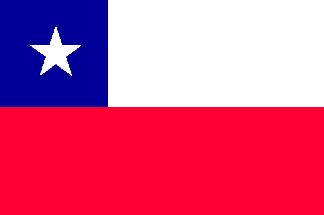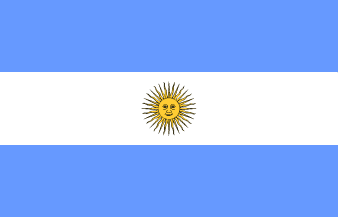Friday
17 March 2005
Today is not
only grey, it is raining cats and dog. We are picked up by Alfredo, our guide
from BueGay, who will
guideus around the districts of San Telmo and La Boca. He first takes us in a
taxi to La Boca. We start - at my request - at the Boca Juniors stadium, La Bombonera
or chocolate box. We buy a T-shirt 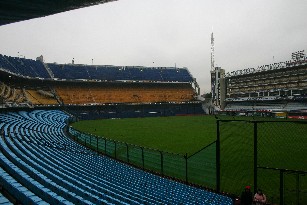 (original merchandise) in the fan shop and take a look at the stadium itself. It
looks a bit poor and has and odd shape. In fact it is half a stadium with a separate
apartment like building closing off the open side. That is were the
business lounges are. Lots of standing room. It suits the working class
neighbourhood and the working class club La Boca. Boca Juniors supporters are
extremely faithful and fanatical. It is home for superstar Diego Maradona, who
is vice-president now. He is still idolised for his football qualities. His
lifestyle is less popular. From the stadium we walk into the neighbourhood, one
of the oldest in the city. Here, the poor Italian immigrants were housed who
worked on the shipyards and the docks. The built their houses with leftovers
they took home from work
(original merchandise) in the fan shop and take a look at the stadium itself. It
looks a bit poor and has and odd shape. In fact it is half a stadium with a separate
apartment like building closing off the open side. That is were the
business lounges are. Lots of standing room. It suits the working class
neighbourhood and the working class club La Boca. Boca Juniors supporters are
extremely faithful and fanatical. It is home for superstar Diego Maradona, who
is vice-president now. He is still idolised for his football qualities. His
lifestyle is less popular. From the stadium we walk into the neighbourhood, one
of the oldest in the city. Here, the poor Italian immigrants were housed who
worked on the shipyards and the docks. The built their houses with leftovers
they took home from work 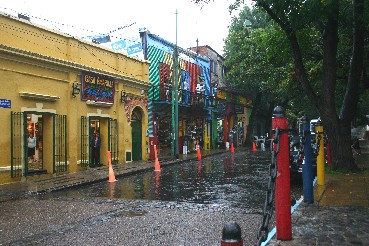 . The original houses consist of iron plates, colourful painted in different
colours. The tradition of this has to do with the poor past in which the workers
to home leftovers of paint from work. If a tin of paint ran out they continued
with another colour. Now the colour patterns are more planned. Not a few people
have painted their house in the colours of the football club. We walk
through a number of typical La Boca streets, among which El Caminito. It
is a bit too typical and looks a bit like an open air museum. Very few people
live in this part of La Boca and we see dozens of souvenir shops in the brightly
coloured houses. The side walks are very high. This is because this district
used to flood very often. We have coffee in a typical bar at the docks with a
view on the famous bridge, the
Puente Transbordador over the river Riachuelo on which estuary (La Boca) the
neighbourhood is founded. De river is heavily polluted and Porteños from other
districts, at hearing the name La Boca, jokingly pinch their noses.
. The original houses consist of iron plates, colourful painted in different
colours. The tradition of this has to do with the poor past in which the workers
to home leftovers of paint from work. If a tin of paint ran out they continued
with another colour. Now the colour patterns are more planned. Not a few people
have painted their house in the colours of the football club. We walk
through a number of typical La Boca streets, among which El Caminito. It
is a bit too typical and looks a bit like an open air museum. Very few people
live in this part of La Boca and we see dozens of souvenir shops in the brightly
coloured houses. The side walks are very high. This is because this district
used to flood very often. We have coffee in a typical bar at the docks with a
view on the famous bridge, the
Puente Transbordador over the river Riachuelo on which estuary (La Boca) the
neighbourhood is founded. De river is heavily polluted and Porteños from other
districts, at hearing the name La Boca, jokingly pinch their noses.
We take a taxi
and 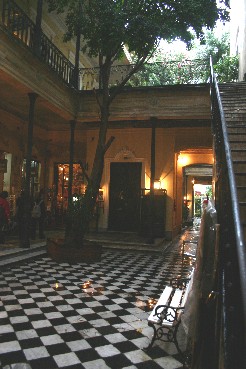 drive
to San Telmo, a neighbourhood with a more distinguished past. This was the
neighbourhood vor the rich, who left it in 1871 after a yellow fever epidemic.
Family palaces were split into tenements, rented out to immigrants. Many of the
old houses have kept their original appearance and charm because the new
landlords did have the money to do much work on them. It is still a
working class neighbourhood, but there are also many artists and antique shops,
which makes it very attractive. drive
to San Telmo, a neighbourhood with a more distinguished past. This was the
neighbourhood vor the rich, who left it in 1871 after a yellow fever epidemic.
Family palaces were split into tenements, rented out to immigrants. Many of the
old houses have kept their original appearance and charm because the new
landlords did have the money to do much work on them. It is still a
working class neighbourhood, but there are also many artists and antique shops,
which makes it very attractive.
We start in
the Pasaje de la Defesa, and old town house of the Ezeiza family, which now
serves as an antique mall with lots of old stuff and souvenirs. Further on on
the Plaza Dorego we peek into the old Plaza Dorrego Bar. The square is the
centre of the flee market on Sunday mornings. San
Pedro Telmo church is one of the few remaining colonial style buildings. The
facade is especially interesting. We continue to the Mercado Municipal, the
market hall, where antiques and fresh food are on offer. It is still raining
when we take a taxi to the Plaza de Mayo, to have a look at the presidential
palace, the Casa
Rosada, the pink house. The Plaza de Mayo has been the political heart of the
country since colonial days. The present presidential palace was built in 1873
on the same spot as the old Spanish fortress. The left part used to be the Main
Post Office, while right part was built as presidential palace. In 1886 both
buildings were united by an arch between them. From the palace balcony Evita
Peron used to address the people and Madonna sang here “Don’t Cry For Me Argentina”
in the film
Evita . The film was shot here and in Budapest. 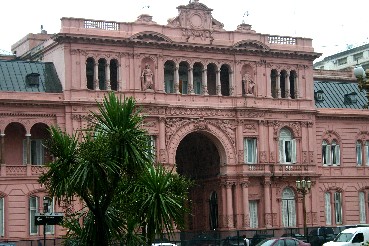 The
Plaza de Mayo was and still is the territory of the Mothers of the Plaza the
Mayo, who still protest here every Thursday to demand the truth about the fate
of their children who disappeared during the military dictatorship from 1976
through 1983. 20 thousand people have disappeared during that time. Many only on
suspicion of oppositional thoughts. The
Plaza de Mayo was and still is the territory of the Mothers of the Plaza the
Mayo, who still protest here every Thursday to demand the truth about the fate
of their children who disappeared during the military dictatorship from 1976
through 1983. 20 thousand people have disappeared during that time. Many only on
suspicion of oppositional thoughts.
We carry a
little bit more to Puerto
Madero, behind the Casa Rosada. We can see now that only the front of the
palace has been painted pink. Alfredo has to admit that lack of money is the
reason for that. We arrive at the Puerto. The docks here have been left unused
for over 50 years, since they became too small in the 1930's. In 1989
the city council decided to redevelop the area, like so many old docklands in
major port cities. The warehouses of old are now offices, hotels and posh
restaurants. The docks themselves have been converted into marinas. We land in
the Cabañas
las Lilas and have the lunch of our lives. Delicious Argentine beef. Great
hors d'houvres and very good Cabernet Sauvignon. The restaurant is part of an
agricultural firm specialising in breeding cows. We want to take a taxi to the
hotel, but they are hard to find in this kind of weather. When finally find one
we get stuck in a traffic jam. We get out and take the underground instead.
It is not
until 4pm that the rain finally stops. I go out to shoot some typical Porteño
scenes with my camera. 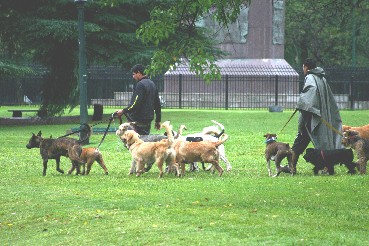 First an old paper collector, who draws a big cart behind him, scanning the
garbage for usable old paper. There are also people digging for something
edible. All that in the affluent barrio of Palermo. It is the dark side of
the economic crisis of 2001, which Argentina has problems to shake off. Also a
juggler, who does his act in front of cars waiting for a red traffic light. But
most typical sight are the paseperros. The dog walkers. In the parks, especially
on weekdays the young athletic men walking 5, 6 or even 12 dogs are a regular
phenomenon. The dogs' rich, hard working bosses are too busy to walk themselves,
which is why they choose to source it out. It is a big difference from the packs
of dogs we have seen in rural areas, which were left to their own devices.
First an old paper collector, who draws a big cart behind him, scanning the
garbage for usable old paper. There are also people digging for something
edible. All that in the affluent barrio of Palermo. It is the dark side of
the economic crisis of 2001, which Argentina has problems to shake off. Also a
juggler, who does his act in front of cars waiting for a red traffic light. But
most typical sight are the paseperros. The dog walkers. In the parks, especially
on weekdays the young athletic men walking 5, 6 or even 12 dogs are a regular
phenomenon. The dogs' rich, hard working bosses are too busy to walk themselves,
which is why they choose to source it out. It is a big difference from the packs
of dogs we have seen in rural areas, which were left to their own devices.
At night we
have drink nearby before we go to Inside Restobar. The atmosphere is good, the
service very friendly, but the food is awful, drowned in cheese.
We go back to
the hotel for a few hours sleep. At one we get up again for a night out.
Nightlife does not start here before 1 or 2 in the morning. We take a taxi to bar Bulnes
Class. A trendy lounge bar, with many happy, handsome and well groomed
Porteños.
Weather: Heavy
rain. 17 degrees. dry at night..
Saturday
18 March 2006
We sleep in
and enjoy once more the delicious breakfast, served again by the irresistible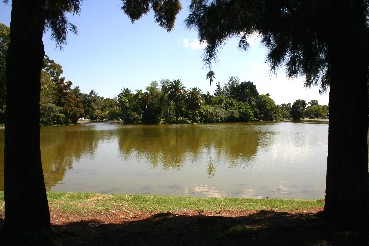 waiters of BoBo hotel. After that we take the underground to Retiro station.
According to Alfredo, our guide yesterday, that should be a fine example of
British railway architecture. And indeed, he did exaggerate. Unfortunately
the station hall is filled with shops and cars. Than we take a taxi to 3 de
Febrero park, a kind of Central Park in Buenos
Aires. It is Saturday and the sun is shining brightly and the Porteños are
relaxing here or exercising as the case may be.
waiters of BoBo hotel. After that we take the underground to Retiro station.
According to Alfredo, our guide yesterday, that should be a fine example of
British railway architecture. And indeed, he did exaggerate. Unfortunately
the station hall is filled with shops and cars. Than we take a taxi to 3 de
Febrero park, a kind of Central Park in Buenos
Aires. It is Saturday and the sun is shining brightly and the Porteños are
relaxing here or exercising as the case may be. 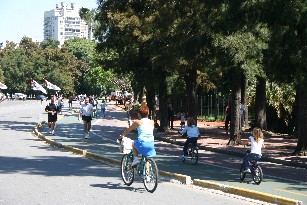 We see lots of joggers, in-line skaters and cyclists around the lake. But there
also many taking a leisurely stroll or having a picnic in the sun. We watch the Porteños at play
from a park bench. Alas there are no outside café's. There is a beautiful rose
garden, with roses and a collection
We see lots of joggers, in-line skaters and cyclists around the lake. But there
also many taking a leisurely stroll or having a picnic in the sun. We watch the Porteños at play
from a park bench. Alas there are no outside café's. There is a beautiful rose
garden, with roses and a collection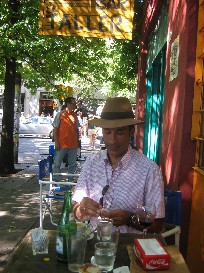 of statues of writers and poets from all over the world. After a couple
of hours we return to Palermo to have lunch and a drink. We go back to El Taller
on Plaza Serrano. We enjoy the view and passers by. We then stroll around the
area, that has a good deal of ultra hip and trendy interior decorating and
furniture shops, fashion shops and cafe's. We sit down at another side walk
café for a beer. After that we walk back to the hotel. Around 7pm we take a
taxi to the international
airport near Ezeiza. From Palermo it is aproximately a 45 minutes' drive. We
check in, have something to eat in a snackbar and wait for our flight. At
10.35pm we take off on our Iberia
flight to Madrid. Again it is a long flight. 12 hours to Madrid. There we have
plenty of time to transfer to our connecting flight to Amsterdam, where we
arrive two hours later at 6.50pm. We are back home in icy cold and Rotterdam
around 8.15.
of statues of writers and poets from all over the world. After a couple
of hours we return to Palermo to have lunch and a drink. We go back to El Taller
on Plaza Serrano. We enjoy the view and passers by. We then stroll around the
area, that has a good deal of ultra hip and trendy interior decorating and
furniture shops, fashion shops and cafe's. We sit down at another side walk
café for a beer. After that we walk back to the hotel. Around 7pm we take a
taxi to the international
airport near Ezeiza. From Palermo it is aproximately a 45 minutes' drive. We
check in, have something to eat in a snackbar and wait for our flight. At
10.35pm we take off on our Iberia
flight to Madrid. Again it is a long flight. 12 hours to Madrid. There we have
plenty of time to transfer to our connecting flight to Amsterdam, where we
arrive two hours later at 6.50pm. We are back home in icy cold and Rotterdam
around 8.15.
Weather:
sunny and warm.
26 degrees. In the Netherlands 4 degrees.
|
